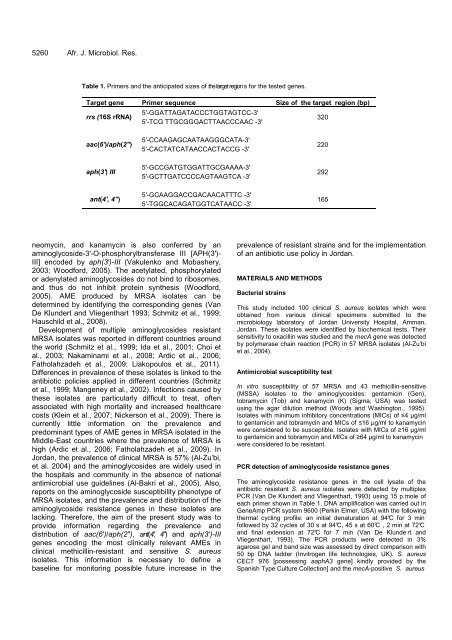Microbiology Research - Academic Journals
Microbiology Research - Academic Journals
Microbiology Research - Academic Journals
Create successful ePaper yourself
Turn your PDF publications into a flip-book with our unique Google optimized e-Paper software.
5260 Afr. J. Microbiol. Res.<br />
Table 1. Primers and the anticipated sizes of the target region s for the tested genes.<br />
Target gene Primer sequence Size of the target region (bp)<br />
rrs (16S rRNA)<br />
aac(6')/aph(2")<br />
aph(3') III<br />
ant(4', 4")<br />
5'-GGATTAGATACCCTGGTAGTCC-3'<br />
5'-TCG TTGCGGGACTTAACCCAAC -3'<br />
5'-CCAAGAGCAATAAGGGCATA-3'<br />
5'-CACTATCATAACCACTACCG -3'<br />
5'-GCCGATGTGGATTGCGAAAA-3'<br />
5'-GCTTGATCCCCAGTAAGTCA -3'<br />
5'-GCAAGGACCGACAACATTTC -3'<br />
5'-TGGCACAGATGGTCATAACC -3'<br />
neomycin, and kanamycin is also conferred by an<br />
aminoglycoside-3'-O-phosphoryltransferase III [APH(3')-<br />
III] encoded by aph(3′)-III (Vakulenko and Mobashery,<br />
2003; Woodford, 2005). The acetylated, phosphorylated<br />
or adenylated aminoglycosides do not bind to ribosomes,<br />
and thus do not inhibit protein synthesis (Woodford,<br />
2005). AME produced by MRSA isolates can be<br />
determined by identifying the corresponding genes (Van<br />
De Klundert and Vliegenthart 1993; Schmitz et al., 1999;<br />
Hauschild et al., 2008).<br />
Development of multiple aminoglycosides resistant<br />
MRSA isolates was reported in different countries around<br />
the world (Schmitz et al., 1999; Ida et al., 2001; Choi et<br />
al., 2003; Nakaminami et al., 2008; Ardic et al., 2006;<br />
Fatholahzadeh et al., 2009; Liakopoulos et al., 2011).<br />
Differences in prevalence of these isolates is linked to the<br />
antibiotic policies applied in different countries (Schmitz<br />
et al., 1999; Mangeney et al., 2002). Infections caused by<br />
these isolates are particularly difficult to treat, often<br />
associated with high mortality and increased healthcare<br />
costs (Klein et al., 2007; Nickerson et al., 2009). There is<br />
currently little information on the prevalence and<br />
predominant types of AME genes in MRSA isolated in the<br />
Middle-East countries where the prevalence of MRSA is<br />
high (Ardic et al., 2006; Fatholahzadeh et al., 2009). In<br />
Jordan, the prevalence of clinical MRSA is 57% (Al-Zu’bi,<br />
et al. 2004) and the aminoglycosides are widely used in<br />
the hospitals and community in the absence of national<br />
antimicrobial use guidelines (Al-Bakri et al., 2005). Also,<br />
reports on the aminoglycoside susceptibility phenotype of<br />
MRSA isolates, and the prevalence and distribution of the<br />
aminoglycoside resistance genes in these isolates are<br />
lacking. Therefore, the aim of the present study was to<br />
provide information regarding the prevalence and<br />
distribution of aac(6′)/aph(2′′), ant(4', 4") and aph(3′)-III<br />
genes encoding the most clinically relevant AMEs in<br />
clinical methicillin-resistant and sensitive S. aureus<br />
isolates. This information is necessary to define a<br />
baseline for monitoring possible future increase in the<br />
320<br />
220<br />
292<br />
165<br />
prevalence of resistant strains and for the implementation<br />
of an antibiotic use policy in Jordan.<br />
MATERIALS AND METHODS<br />
Bacterial strains<br />
This study included 100 clinical S. aureus isolates which were<br />
obtained from various clinical specimens submitted to the<br />
microbiology laboratory of Jordan University Hospital, Amman,<br />
Jordan. These isolates were identified by biochemical tests. Their<br />
sensitivity to oxacillin was studied and the mecA gene was detected<br />
by polymerase chain reaction (PCR) in 57 MRSA isolates (Al-Zu’bi<br />
et al., 2004).<br />
Antimicrobial susceptibility test<br />
In vitro susceptibility of 57 MRSA and 43 methicillin-sensitive<br />
(MSSA) isolates to the aminoglycosides: gentamicin (Gen),<br />
tobramycin (Tob) and kanamycin (K) (Sigma, USA) was tested<br />
using the agar dilution method (Woods and Washington., 1995).<br />
Isolates with minimum inhibitory concentrations (MICs) of ≤4 µg/ml<br />
to gentamicin and tobramycin and MICs of ≤16 µg/ml to kanamycin<br />
were considered to be susceptible. Isolates with MICs of ≥16 µg/ml<br />
to gentamicin and tobramycin and MICs of ≥64 µg/ml to kanamycin<br />
were considered to be resistant.<br />
PCR detection of aminoglycoside resistance genes<br />
The aminoglycoside resistance genes in the cell lysate of the<br />
antibiotic resistant S. aureus isolates were detected by multiplex<br />
PCR (Van De Klundert and Vliegenthart, 1993) using 15 p.mole of<br />
each primer shown in Table 1. DNA amplification was carried out in<br />
GeneAmp PCR system 9600 (Perkin Elmer, USA) with the following<br />
thermal cycling profile: an initial denaturation at 94°C for 3 min<br />
followed by 32 cycles of 30 s at 94°C, 45 s at 60°C , 2 min at 72°C<br />
and final extension at 72°C for 7 min (Van De Klunde rt and<br />
Vliegenthart, 1993). The PCR products were detected in 3%<br />
agarose gel and band size was assessed by direct comparison with<br />
50 bp DNA ladder (Invitrogen life technologies, UK). S. aureus<br />
CECT 976 [possessing aaphA3 gene] kindly provided by the<br />
Spanish Type Culture Collection] and the mecA-positive S. aureus

















